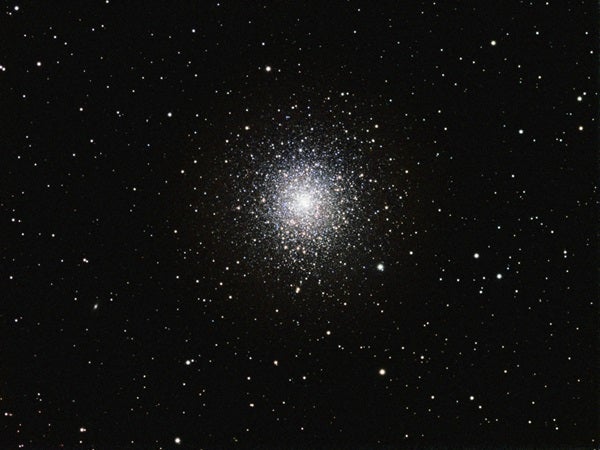One of the northern night sky’s superb globular star cluster wonders is our next target: M92 in Hercules. Visible through binoculars as a diffuse star, M92 is a tantalizing sight through telescopes of all sizes. This understated but fascinating cluster rivals the Great Globular Cluster in Hercules (M13) in wonder, being only a half magnitude fainter and 6′ smaller. Both of their brightest stars shine within range of small telescopes (12th magnitude) and can be fully resolved if one can reach to 15th magnitude. M92 “suffers” only in that its core is more compact than M13’s, so higher powers and greater patience are required to fully appreciate its glory. As Robert Burnham Jr. noted, if M92 were in any other constellation, it would be considered a showpiece.
Johann Elert Bode discovered the cluster in 1777, saying it was “more or less round, with a pale glow,” which hardly does it justice by modern standards. Even Messier resolved no stars in it, noting that the core, however, was “clear and bright” and “resembles the nucleus of a large comet.” William Herschel first recognized it as a cluster, while his son John saw this “globular cluster” resolve into “small stars.”
Modern studies have shown M92 is a stunning inner halo globular cluster system 27,000 light-years distant — a tad closer than M13 but about 20 light-years smaller. It harbors more than 300,000 suns. Like M13, it can be glimpsed with unaided eyes under a dark sky, just 5° southwest of Iota (ι) Herculis, though it is a more significant feat to see it.
The cluster lies near the farthest point in its orbit around the Milky Way Galaxy — about 32,000 light-years from the galaxy’s center — and astronomers believe the 11-billion-year-old system has already made 16 perigalactic transits in its lifetime. Due to these passages, the cluster has periodically been stripped of its stars. In images, M92 exhibits long tidal tails, especially in the northeast-southwest direction along its orbit.
Use high powers to explore the cluster’s core and halo, which is strongly asymmetrical to the north, taking the form of a lobster-claw-like arrangement of bright suns.
Make sure to explore Astronomy’s full list of 101 cosmic objects you must see. New entries will be added each week throughout 2022.
To get the latest astronomical news and observing content delivered directly to your door, subscribe to Astronomy magazine today!










